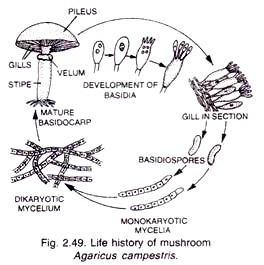Read this essay on the main causes of cancer!
Cancer is a disease involving heritable defects in cellular control mechanisms.
As a result of this, cancer cells proliferate uncontrollably forming malignant tumors which grow irregular. Besides, these cells spread to surrounding tissues (metastases) therefore infecting several parts of the body.
These cancer cells have a tendency to exhibit an abnormal number of chromosome (aneuploidy), ability to divide indefinitely, disorganized cytoskeleton and lack of responsiveness to neighbouring cells.
Causes of Cancer:
Normal cells can be converted to cancer cells by treatment with a wide variety of chemicals, ionizing radiations and several DNA and RNA-containing viruses. Broadly speaking, two large groups of viruses appear to be carcinogenic.
They include DNA tumor viruses and RNA tumor viruses, depending on the type of nucleic acid present within the mature virus particle. Among DNA tumor viruses, there are simian virus 40 (SV 40), adenovirus, polyoma virus and herpes like virus. The RNA tumor viruses include retroviruses similar to HIV.
Two kinds of genes have been found to be associated with carcinogenesis:
These comprise tumor – suppressor genes and oncogenes.
1. Tumor – suppressor genes:
These are anti-oncogenes and encode proteins which restrain cell growth and prevent cells from becoming malignant. First tumor – suppressor gene resulting in eye cancer called retinoblastoma was discovered, designated as RB. It was caused due to deletion in one member of 13th pair of chromosome. Other cancers caused by tumor-suppressor genes include colon carcinoma, nephroblastoma, neurofibromas and thyroid carcinoma etc.
2. Oncogenes:
These genes encode proteins which promote the loss of growth control and conversion of a cell to a malignant state. The existence of oncogenes was discovered by investigations on RNA tumor viruses. An oncogene called Src which was carried by a RNA tumor virus – avian sarcoma virus (ASV) was actually present in the genome of uninfected cells.
Therefore, cells possess a variety of genes — proto-oncogenes which have the potential to convert cell’s activities toward malignant state.
A retrovirus has only three genes required for its life cycle and has terminal repeats at its ends. Some retroviruses, the oncogenic ones (i.e., producing cancer cells), carry an extra gene that induces cancer in animals. Many oncogenic viruses have been isolated, each one having one oncogene, and these have been shown to be able to carry over 20 different oncogenes. Many independently isolated viruses have been found to carry the same gene.
The Src gene of Rous sarcoma virus codes for a plasma-membrane- bound protein kinase that phosphorylates the amino acid tyrosine on proteins on the cell membrane. In 1968 Huebner and Todaro predicted that normal cells contained enemies within in the form of oncogenes similar to the viral one, which could produce cancer when activated.
About 100 different oncogenes have been identified.
These genes cause cancer in many ways as shown below:
(a) Oncogenes encoding growth factor or their receptors:
Cancer-causing simian sarcoma virus (SIS) contained a gene SIS that codes for platelet- derived growth factor (PDGF) and secretes large amount of PGDF into blood and causing cells to proliferate in an uncontrolled fashion. Another oncogene erbB directs the formation of an altered EGF receptor and thus causing human skin cancer.
(b) Oncogenes that encode cytoplasmic protein kniases:
There are large number of oncogenes which are responsible for the synthesis of several protein kinases resulting in cancer. These include Raf responsible for serine – threonine kniase. Another oncogene Src is also a protein kinase which phosphorylates tyrosine residues on protein substrates.
(c) Oncogenes which encode nuclear transcription factors:
Among this category, there are oncogene myc responsible for carcinoma of lung, cervix and breast. Large amount of Мус protein is synthesized resulting in uncontrolled cell proliferation.
(d) Oncogenes that encode products affecting apoptosis:
Apoptosis is one of the body’s mechanisms to rid itself of tumor cells at an early stage of malignancy. Oncogenes — bcl-2 is closely related to apoptosis and encodes membrane-bound protein which inhibits apoptosis in certain tissues.
Proto-oncogene:
All 20 viral oncogenes derive from cellular genes in normal cells. The normal cellular version of the gene is called a proto-oncogene. Retroviruses pick up into their genome sequences from mRNA population that will increase viral production (by increasing cell proliferation). These viruses can transmit genes from one species to another, thus breaking evolutionary barriers (Bishop, 1983).
Another agent that stimulates proliferation, epidermal growth factor (EGF), like Svc, increases phosphorylation of membrane proteins at tyrosines. It is thought that this tyrosine phosphorylation somehow controls cell proliferation. Cancer cells (also called transformed cells) contain ten times more phosphotyrosine than normal cells.
About half of the oncogenes code for Tyr protein kinases and in all cases the proteins are integral components of the cell membrane. Most oncogenes seem to be related in one way or another with the same pathway of regulation of cell proliferation by protein growth factors.
EGF stimulates lung development and differentiation. In intact organisms, the production of growth factor induces multiplication at a short distance only, stimulating the cell that secretes it and the nearby cells. This is sometimes called autocrine secretion. When EGF reaches the membrane of a target cell it binds to a specific receptor protein of 170,000 Daltons, and the complex is subsequently internalized.
The receptor protein becomes phosphorylated during this process and the phosphorus binds to tyrosine. Phosphorylation of tyrosine is rare in proteins except in cells that have been transformed by retroviruses and become cancerous. Both in EGF and in viral transformation phosphorylation of tyrosine results in increased cell proliferation. Cells start dividing only after many hours of adding the growth factors.
Growth inhibitors, called chalones (Gr., to slow down) are numerous, which have been isolated from tissues. These are also numerous and important as growth factors.

